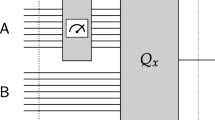Abstract
Quantum pseudo-telepathy (QPT) is a new type of game where the quantum team can win with certainty while the classical one cannot. It means the advantages of quantum participants over classical ones in game. However, there has been no systematic and formal analysis on the QPT game before. Here we present the formal description of the QPT game and the definition of the most simplified QPT. Based on the above definitions, we simplify a famous QPT game, i.e. the Cabllo game. Then, according to some instances, we analyze the minimum best success probability by classical strategies of the two-player QPT, which reflects the advantage of the quantum strategies. Finally, we prove the best success probability by classical strategies for the most simplified QPT is totally related to the number of all possible question combinations.
Similar content being viewed by others
References
Cleve R, Hoyer P, Toner B, et al. Consequences and Limits of Nonlocal Strategies. In: Proceedings of the 19th IEEE Conference on Computational Complexity, 2004. 236–249
Einstein A, Podolsky B, Rosen N. Can Quantum Mechanics description of physical reality be considered complete? Phys Rev, 1935, 47: 777
Greenberger D M, Horne M, Zeilinger A. Going beyond Bell’s theorem, in Bell’s Theorem, Quantum Theory, and Conceptions of the Universe. Kafatos M, ed. Dordrecht: Kluwer Academic, 1989. 69–72
Aharon N, Vaidman L. Quantum advantages in classically defined tasks. Phys Rev A, 2008, 77: 052310
Vaidman L. Tests of Bell inequalities. Phys Lett A, 2001, 286: 241–244
Cabello A. Stronger two-observer all-versus-nothing violation of local realism. Phys Rev Lett, 2005, 95: 210401
Cabello A. Two-player quantum pseudotelepathy based on recent all-versus-nothing violations of local realism. Phys Rev A, 2006, 73: 022302
Brassard G, Broadbent A, Tapp A. Recasting Mermin’s multiplayer game into the framework of pseudo-telepathy. Quantum Inf C, 2005, 5: 538
Brassard G, Broadbent A, Tapp A. Quantum Pseudo-Telepathy. Foundations Phys, 2005, 35: 1877–1907
Brassard G, Broadbent A, Tapp A. Minimum entangled state dimension required for pseudo-telepathy. arXiv:quant-ph/0412136v2
WEN W. The quantification of quantum nonlocality by characteristic function. Sci China-Phys Mech Astron, 2013, 56(5): 947–951
Author information
Authors and Affiliations
Corresponding author
Rights and permissions
About this article
Cite this article
Gao, F., Fang, W. & Wen, Q. Minimum best success probability by classical strategies for quantum pseudo-telepathy. Sci. China Phys. Mech. Astron. 57, 1244–1249 (2014). https://doi.org/10.1007/s11433-014-5485-2
Received:
Accepted:
Published:
Issue Date:
DOI: https://doi.org/10.1007/s11433-014-5485-2




